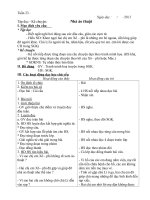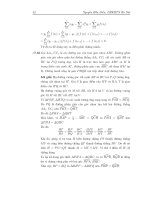Tài liệu Olympic toán toàn quốc - Việt nam 2000 pdf
Bạn đang xem bản rút gọn của tài liệu. Xem và tải ngay bản đầy đủ của tài liệu tại đây (44.07 KB, 1 trang )
Toán học, Olympic toán toàn quốc - Việt nam 2000
Bài từ Tủ sách Khoa học VLOS.
A1. Define a sequence of positive reals x0, x1, x2, ... by x0 = b, xn+1 = �"(c - �"(c +
xn)). Find all values of c such that for all b in the interval (0, c), such a sequence exists and
converges to a finite limit as n tends to infinity.
A2. C and C' are circles centers O and O' respectively. X and X' are points on C and C'
respectively such that the lines OX and O'X' intersect. M and M' are variable points on C
and C' respectively, such that "XOM = "X'O'M' (both measured clockwise). Find the locus
of the midpoint of MM'. Let OM and O'M' meet at Q. Show that the circumcircle of QMM'
passes through a fixed point.
A3. Let p(x) = x3 + 153x2 - 111x + 38. Show that p(n) is divisible by 32000 for at least
nine positive integers n less than 32000. For how many such n is it divisible?
B1. Given an angle ±� such that 0 < ±� < À�, show that there is a unique real monic
quadratic x2 + ax + b which is a factor of pn(x) = sin ±� xn - sin(n±�) x + sin(n±�-±�)
for all n > 2. Show that there is no linear polynomial x + c which divides pn(x) for all n >
2.
B2. Find all n > 3 such that we can find n points in space, no three collinear and no four on
the same circle, such that the circles through any three points all have the same radius.
B3. p(x) is a polynomial with real coefficients such that p(x2 - 1) = p(x) p(-x). What is the
largest number of real roots that p(x) can have?









